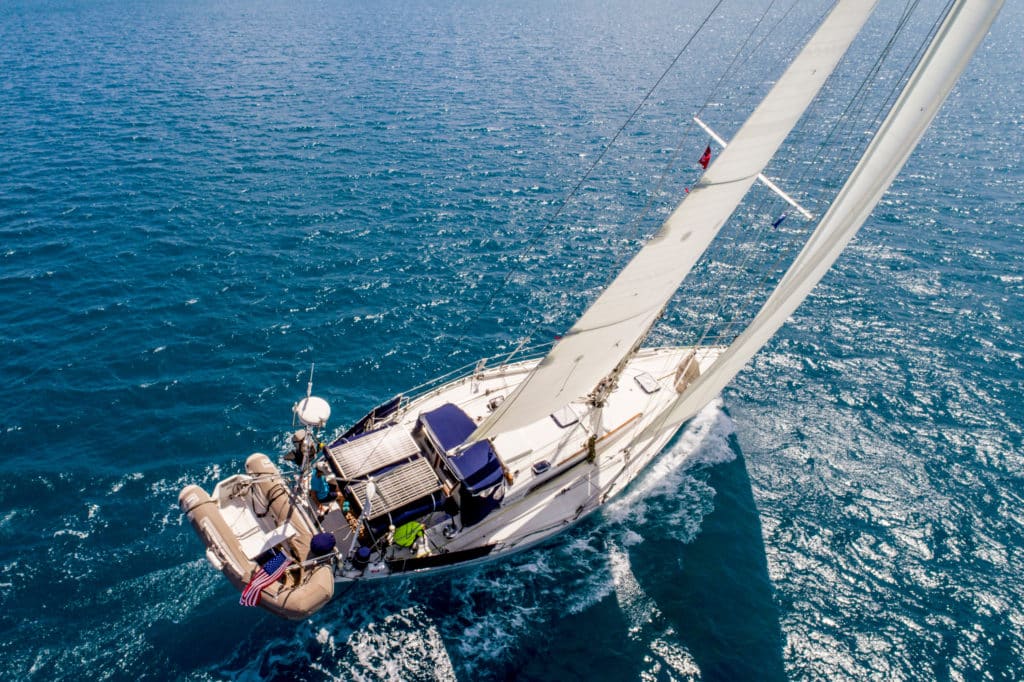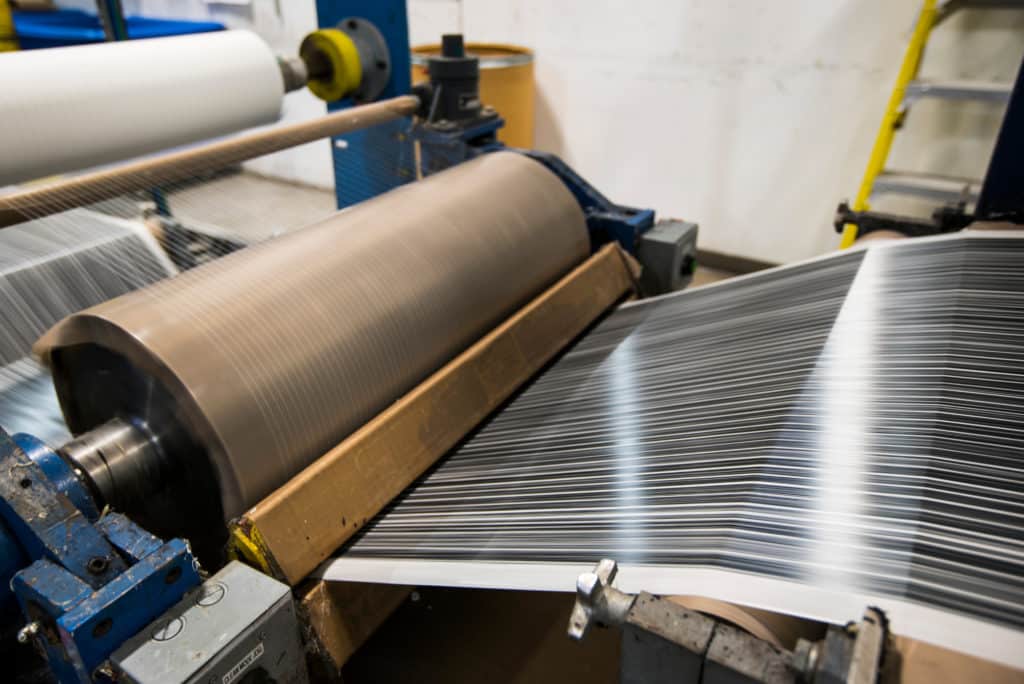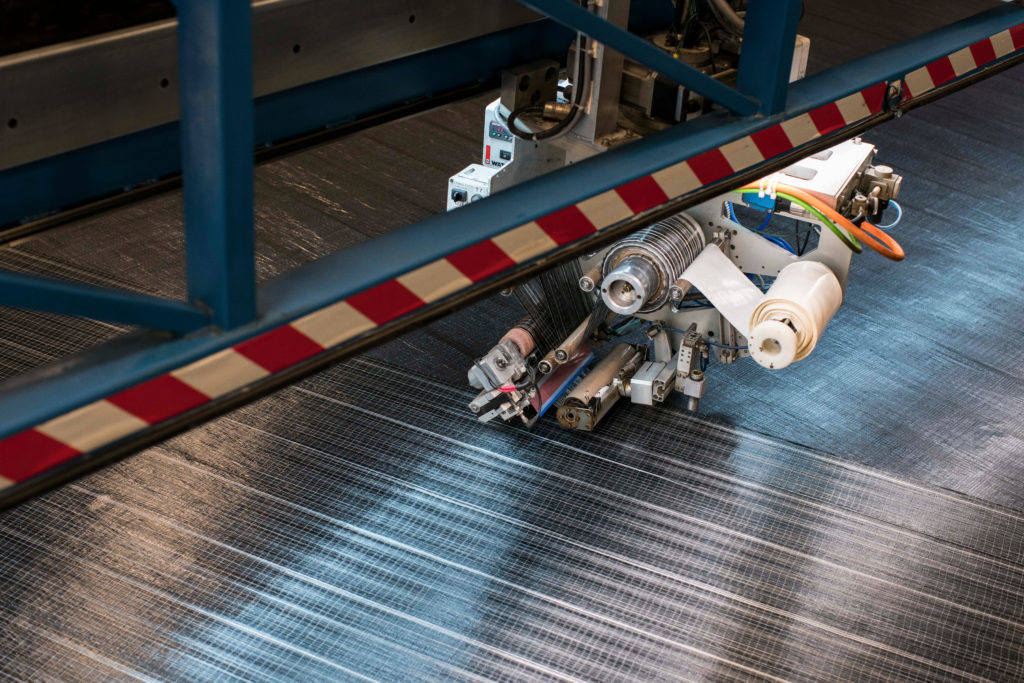
“There is nothing new under the sun.”
That idea, from Ecclesiastes, was new just over 2,400 years ago. Woven cloth was new about 25,000 years ago. Polyester was invented in 1941, and since around 1950, woven polyester cross-cut sails have been the reigning technology on cruising sailboats around the world. (Racing sailboats are a different story.)
3Di Nordac technology, introduced this summer by North Sails and created for cruising sailors who truly want to sail, is something new under the sun.
The Trouble with Weaving

3Di manufacturing at the North Sails sail loft in Minden, Nevada.
“The big difference between a good cruising main and a bad cruising main,” says North Sails CEO Dan Neri, “is the twist profile, where the top of the sail is the most open place on the sail. Then it’s progressively less open when you go down.” On a normal Dacron sail, where you don’t have any control of the stretch, the middle of the leech becomes the most open when it’s time to twist the sail, he says. “That pulls the top of the leech in, which gives a deeper head and open middle. And that makes the boat heel more.”
The question for sailors and sailmakers, then, is: How do you create a sail that holds that desirable shape over time — a shape that delivers the most forward-driving lift with the least speed-killing drag?
The history of sail-making is marked by innovations in both fiber and cloth. The year 1851 was a watershed year. That’s when the schooner America trounced 15 British contenders for the Hundred Guinea Cup, later called the America’s Cup. While all the Brits were flying sails made from flax (linen), America demonstrated something new: cotton (canvas) sails. Retaining a flatter shape, the sails contributed to less heeling moment, a drier foredeck and — most notably for an island empire held together by its sail-powered Royal Navy — a pointing angle that was 6 degrees closer to the wind than that of the nearest competitor.
It was another transatlantic competition, some 90 years later, that produced the next major innovation in sail-making. This was the quest to commercialize organic chemistry. The result was the British discovery of polyethylene terephthalate (PET) — better known as polyester. In 1946, DuPont purchased the patent and called it Dacron.
Since about 1950, cross-cut polyester sails have been the reigning technology on cruising sailboats. Throughout this period, the sailmaker’s goal has been to control stretch. Newer fibers such as carbon, aramid, Spectra or Vectran stretch less but bring other downsides, including cost.
In two-dimensional cloth, warp yarn runs lengthwise and fill yarns run the width. In a fill-oriented cloth, the warp yarns bend, or “crimp,” under and over the fill yarns; such cloth stretches less in the width dimension. “Bias” is the diagonal between warp and fill. The most typical cruising sails are cross-cut sails, made from panels of fill-oriented polyester cloth. Because they stretch least in the width dimension, the panels are aligned perpendicular to the leech, where the primary loads occur. The trouble is, not all of the loads are in that direction, so the sails eventually stretch into rounder, deeper shapes.
Beginning in the 1970s, sailmakers found a way to avoid some of the problems inherent in all woven cloth — particularly stretch in the bias direction. They laminated yarns on a layer of Mylar film (another form of polyester). But with rare exceptions, the downsides of durability, longevity and cost made laminated sails, or “string sails,” more popular for racing sailors than for cruisers. Lamination, many found, was too often attended by its evil twin: delamination. From fiber to cloth, we move from one dimension to two. But sails are three-dimensional airfoils. To create that third dimension of draft, sailmakers cut curved edges into the flat panels of cloth in a technique called “broadseaming.” The placement of the draft is a fundamental difference between good sails and poor sails. When a formerly good sail stretches out, its draft slouches aft.
3Di Nordac Sails

3Di manufacturing at the North Sails sail loft in Minden, Nevada.
North’s 3Di sails were new about 10 years ago and born of yet another transatlantic competition. Neither a weave nor a laminate, 3Di is a composite of flat tapes of fiber layered in a matrix of thermoset resin, much like your boat’s hull. While woven cloth or laminated string sails are “load-path” structures in which virtuous properties align more with some yarns than in other directions, 3Di is different. It’s a quasi-isotropic material — “isotropic” meaning that it exhibits its properties of strength and stretch-resistance in every direction.
During the 1992 America’s Cup event, Bill Koch’s America 3 syndicate introduced a material subsequently called Cuben Fiber. Round yarns, or tows, of fiber (Dyneema, carbon, aramid) are spread out into a flat tape of side-by-side filaments. At the time, Cuben Fiber was used in laminated sails. Then, in 2001, Swiss sailmaker Gérard Gautier imagined such flat tapes put to a different use — one that would get rid of the film in the laminate. In Gautier’s version, the tapes were impregnated with a thermoset resin that, once catalyzed, would hold its shape despite heating or cooling. The Alinghi syndicate tried Gautier’s technology in the run-up to its successful America’s Cup defense in 2007.
Before long, North Sails did what DuPont did with polyester: It bought the patent. But the patent was only for the process, which Gautier accomplished in two dimensions before applying the traditional broadseaming technique to join the panels in a concave shape. North Sails’ engineers adapted Gautier’s idea to their own previous innovations in sail-making directly on a 3D mold. The result was to eliminate seams altogether.
Since 2011, North’s 3Di sails — built with such fibers as carbon or aramid — have been the state of the art for Volvo Ocean Race competitors and other grand-prix race boats. Speaking to durability, Volvo boats previously carried 28 sails per circumnavigation, including three mainsails, says Neri. Using 3Di sails, they can do it with 11 sails and just one main. When Thomas Coville set the solo round-the-world record at 49 days in 2016, he left the dock with 3Di sails that already had 50,000 miles on them. That’s two full circumnavigations.
What’s new under the sun this summer is the combination of 3Di technology with tried-and-true polyester for cruising sailors. With this cloth, sail repairs can be done on the dock, using adhesive. There are also no seams, or the stress risers they cause.
Like all new things, we may still have more to learn about how Dacron behaves in the 3Di environment. But it certainly looks promising for cruising sailors who truly love to sail.
Tim Murphy is a Cruising World editor-at-large and a longtime Boat of the Year judge.








